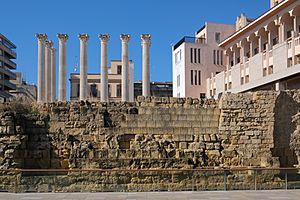Roman temple of Córdoba facts for kids
The city of Córdoba in Spain has the amazing remains of an ancient Roman temple. People found it in the 1950s when they were making the City Hall bigger. You can find it where Claudio Marcelo and Capitulares streets meet. This temple was probably the most important one in the city. It's also the only one we know about from archaeological excavations (when people dig up old things). It was a very large temple, about 32 meters long and 16 meters wide. It had a special style called Corinthian order, known for its fancy columns.
Builders started working on this temple when Emperor Claudius was in charge (around 41–54 AD). They finished it about 40 years later, during the time of Emperor Domitian (around 81–96 CE). Most likely, it was built to honor the Roman emperors, which was called the imperial cult. The temple had some changes made to it in the 2nd century. These changes happened around the same time the main city meeting place, called the forum, was moved. Before the temple was found, people already knew there were old stone pieces in the area. Things like parts of columns and fancy tops of columns (capitals) were found. All these pieces were made of marble, so the area was known as los marmolejos, meaning "the little marbles." This part of Córdoba might have been the main meeting area for the Roman province in the 1st and 2nd centuries. Córdoba was known as Colonia Patricia back then.
What the Temple Looks Like Now
The temple was built on a raised platform called a podium. It had six columns at the front and ten columns along each side. Today, you can still see some parts of the temple. Only its foundation (the base), the stairs, the altar, and some pieces of columns and their tops (called capitals) are left.
The most interesting part of what's left is the foundation. This includes the base that holds up the building and special supports at the front. These supports were shaped like a fan and rested against a wall. Part of this wall can still be seen at City Hall today. These supports were built to stop the heavy marble temple from sliding. This type of support was very rare in the Roman Empire. This makes the Córdoba temple even more special. These strong supports and the huge foundations show us how big and grand the temple must have been. You could have easily seen it from the Via Augusta, which was a main road leading into the city from the east. This road ran next to the circus (a place for chariot races).
You can see some original pieces of the temple, like parts of the columns or capitals, right there. Other pieces were moved to the Archaeological and Ethnological Museum of Córdoba to keep them safe. Some carved stone reliefs and capitals are on display there. You can also see several column pieces in the Plaza de las Doblas.
How the Temple Was Built
The temple was built in the second half of the 1st century. Work started when Emperor Claudius was in charge. But it wasn't finished until Emperor Domitian became emperor. At that time, they even added a water supply to it. The temple had some changes in the 2nd century. These changes seem to have happened when the main provincial meeting area (forum) was moved to where the Convento de Santa Ana is now. Many different materials were used to build it.
Almost everything in the temple was made of marble. This included the columns, the walls, the roof, and the decorative parts above the columns (the entablature). The high quality of the marble and the large size of the pieces tell us something important. It shows that very skilled builders worked on this temple. The final building was as beautiful as the best buildings in the Roman Empire.
The temple stood at the edge of Colonia Patricia, near the western city walls. A small part of the wall was actually taken down to make space for the temple. The land was cleared and made flat. This created a square, man-made terrace. The temple then stood right in the middle of this terrace.
The square around the temple was closed off on three sides: north, east, and south. We know this from old remains found under a building near Claudio Marcelo and Diario Córdoba streets. But the west side was open. This allowed people to see the temple from the circus, which was nearby. Some studies suggest there was another terrace that connected the temple area and the circus.
If the temple was still being used in the 4th century, it would have been closed down. This happened during a time when the Roman emperors, who were now Christian, stopped people from worshiping the old Roman gods.
See also
 In Spanish: Templo romano de Córdoba para niños
In Spanish: Templo romano de Córdoba para niños
- List of Ancient Roman temples
- List of Roman sites in Spain
- Baetica


